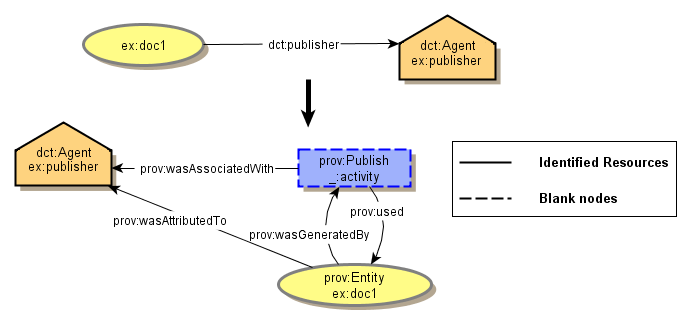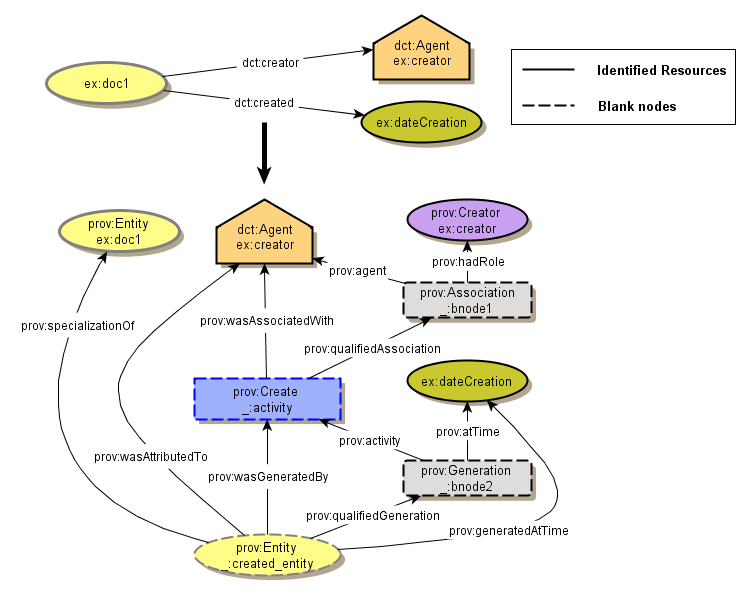This section explains two main particular considerations that should be taken into account regarding the mapping:
2.1 Provenance in Dublin Core
DCMI terms hold a lot of provenance information about a resource: when it was affected in the past,
who affected it and how it was affected. The rest of the DCMI terms (description metadata), tell us what was affected.
Table 1 classifies the DC Terms according to these four categories (what?, who?, when? and how?).
Each category corresponds to the question it answers regarding the description or provenance of a given resource.
The classification is by necessity somewhat minimalistic, as it can be argued that some elements placed in the description metadata terms contain
provenance information as well, depending on their usage. It is worth mentioning that there is no direct information in Dublin Core describing
where a resource was affected. The categories are further explained below:
Descriptive Terms (What?): This category contains all the terms describing a resource without refering to its provenance (a total of 30 out of 55 terms).
Some examples are the dct:title, dct:abstract or dct:description of a resource, the dct:format in which the resource can be found, etc.
Agency Terms (Who?): This category contains agent related terms. All properties have dct:Agent as range,
i.e., a resource that acts or has the power to act. The dct:contributor, dct:creator,
and dct:publisher clearly influence
the resource and therefore are important for its origin. This is not immediately clear for the dct:rightsHolder,
but as ownership is considered the important provenance information for many resources, like artworks, it is included in this category.
Date and Time Terms (When?): This category contains date and time related terms.
Dates belong to the provenance record of a resource, as they track when something was created (dct:created), modified
(dct:modified), published (dct:issued), etc. Two dates can be considered special regarding their relevance for
provenance: dct:available and dct:valid. They are different from the other dates as by definition they can represent a
date range. Often, the range of availability or validity of a resource is inherent to the resource and known
beforehand – consider the validity of a passport or the availability of a limited special offer published on the web.
In these cases, there is no action involved that makes the resource invalid or unavailable, it is simply determined
by the validity range. On the other hand, if an action is involved, e.g., a resource is declared invalid because
a mistake has been found, then it is relevant for its provenance.
Derivation Terms (How?): This category contains derivation related terms.
When a resource is derived from other resources, the original resource becomes part of the provenance
chain of the derived resource. In Dublin Core, derivations can be further classified as versions (dct:isVersionOf),
format serializations (dct:isFormatOf), replacements (dct:replaces) and sources of information (dct:source).
dct:references is a weaker relation (having a reference to a resource does not always mean that the content is derived from it),
but it can be assumed that a referenced resource influenced the described resource
and therefore it is relevant for its provenance. The respective inverse properties do not necessarily contribute to
the provenance of the described resource, e.g., a resource is usually not directly affected by being referenced or
by being used as a source. However, inverse properties belong to the provenance related terms as they can be used to describe the relations
between the resources involved. Finally, licensing (dct:license), rights (dct:rights) and their access (accessRights)
are considered part of the provenance of the resource as well, since they restrict and explain how the resource can be used for further derivation.
Table 1: Categorization of the Dublin Core Terms
| Category |
Sub-category |
Terms |
| Descriptive metadata |
- |
abstract, accrualMethod,
accrualPeriodicity, accrualPolicy,
alternative, audience, bibliographicCitation,
conformsTo, coverage, description,
educationLevel, extent, hasPart,
isPartOf, format, identifier,
instructionalMethod, isRequiredBy, language,
mediator, medium, relation,
requires, spatial, subject,
tableOfContents, temporal, title, type |
| Provenance |
Who |
contributor, creator, publisher, rightsHolder |
| Provenance |
When |
available, created, date, dateAccepted,
dateCopyrighted, dateSubmitted, issued,
modified, valid |
| Provenance |
How |
accessRights, isVersionOf, hasVersion, isFormatOf, hasFormat, license,
references, isReferencedBy, replaces, isReplacedBy, rights,
source |
This leaves one very special term: provenance. This term is defined as a "statement of any changes in ownership and
custody of the resource since its creation that are significant for its authenticity, integrity, and interpretation" [DCTERMS],
a definition that corresponds to the notion of provenance for artworks. This term can be considered a link between the resource and any
provenance statement about the resource, so it cannot be included in any of the aforementioned categories and it is out of the scope of this mapping.
2.2 Entities in Dublin Core
Consider the example metadata record below (Example 1), where a document (ex:doc1) is described
with several DC statements:
Example 1: a simple metadata record:
Example 1
ex:doc1 dct:title "A mapping from Dublin Core..." ;
dct:creator ex:kai, ex:daniel, ex:simon, ex:michael ;
dct:created "2012-02-28" ;
dct:publisher ex:w3c ;
dct:issued "2012-02-29" ;
dct:subject ex:dublincore ;
dct:replaces ex:doc2 ;
dct:format "HTML" .
In
Example 1,
dct:title,
dct:subject and
dct:format
are descriptions of the resource
ex:doc1.
They do not provide any information on how the resource was created or modified in the past.
On the other hand, some statements imply provenance-related information. For example
dct:creator
implies that the document has been created and refers to an author. Similarly, the existence
of the
dct:issued date implies that the document has been published. This information is redundantly
implied by the
dct:publisher statement as well. Finally,
dct:replaces relates
ex:doc1 to the document
ex:doc2, a previous resource representing the mapping.
As a
dc
metadata record describes the document as a whole,
it is not clear how this document relates to the different states that the document had until it reached its final state.
For example, a document may have a
dct:created date and a
dct:issued date. According to
the PROV ontology, the activity of issuing a document involves two different states of the document: the document before it was issued
and the issued document. Each of these states correspond to a different
prov:specialization of the document. Generally,
there are two approaches to deal with this issue:
1) Create new instances of entities that are all related to the original
document by means of prov:specializationOf. For example, consider the
translation of a single dct:publisher statement (as shown on the top of Figure 1):
having a publisher implies a "Publish" activity (represented with a blank node), which is related to the ex:publisher agent. The
activity must have taken as input the document to be published (:_usedEntity, which is a prov:sprecializationOf the
resource we are describing), and generated the published resource (:_resultingEntity). Since we cannot ensure that the published
resource has not suffered any further modifications, :_resultingEntity is also a prov:specializationOf the resource
ex:doc1.
2) Adopt the original resource (ex:doc1) as the prov:Entity used and then generated by the Publish activity
(:_activity). However, this representation leads to a misinterpretation of the DC statement, as shown in the example of
Figure 2. The representation implies that ex:doc1
was generated by _:activity and then used by _:activity afterwards, instead of being used and then being generated by
_:activity (prov:Entities must exist before being used).
Since the first option provides a correct interpretation of the DC statements, it has been chosen as guideline in the complex mapping.
Blank nodes are used for the mapping, although any naming mechanism could be provided if necessary,
leaving the conflating of nodes to the clean-up phase.



